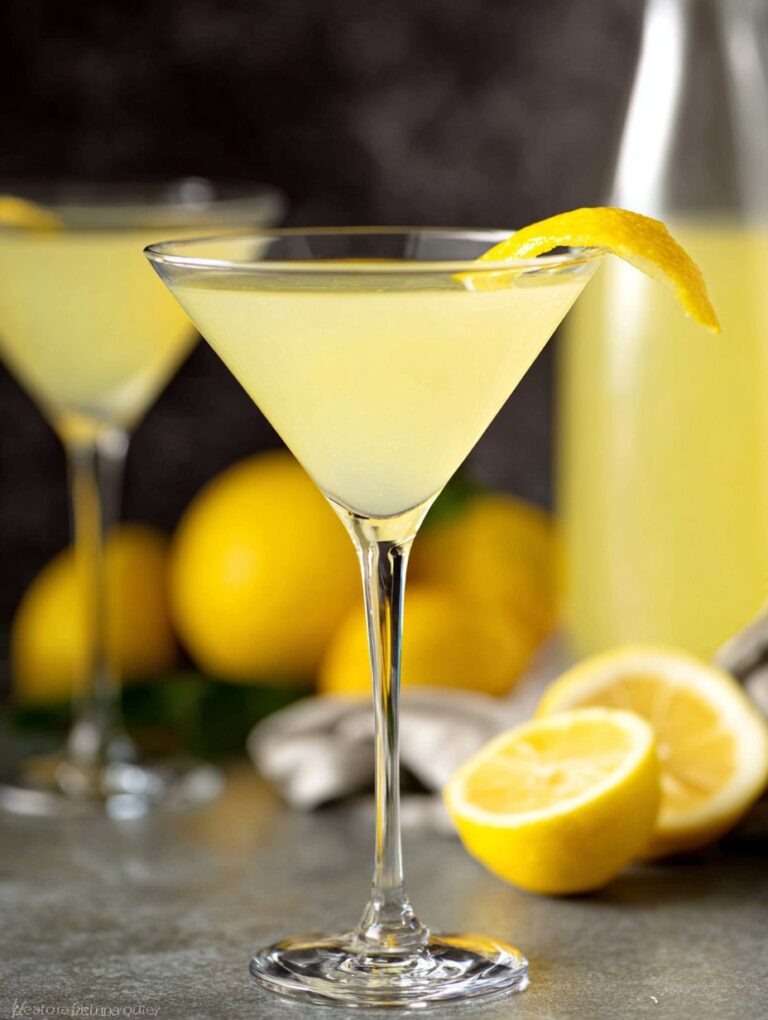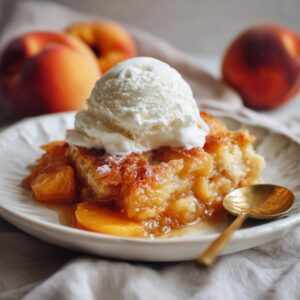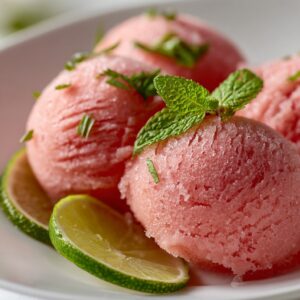Let Me Tell You About This Limoncello Martini
Okay, so I have to confess: the first time I tried a limoncello martini was at my cousin’s backyard wedding—yes, the one with the cheese fountain disaster—and it was the only thing that kept me going through the endless speeches. Ever since then, it’s been my secret weapon when friends drop by unexpectedly or when I just want something bright and zippy after a long week. Seriously, this is one of those drinks that makes you feel a little bit fancy without actually having to put on real pants. (Honestly, I make it in my pajamas more often than I’d admit!)
Why You’ll Love This (Trust Me)
I make this limoncello martini when I want to feel like I’m on some sunny coast in Italy, even though I’m actually staring at my neighbor’s questionable lawn decor. My family goes crazy for this because it’s citrusy, barely sweet, and it disappears faster than you can say cheers—though, one time my uncle insisted we add extra vodka and, well, let’s just say things got interesting. Oh, and if you’ve ever had a martini that tasted like nail polish remover? I promise, this isn’t that. I was skeptical about mixing vodka and limoncello at first, too, but now I can’t stop.
What You’ll Need (And What You Can Swap)
- 2 oz vodka (I usually just use whatever’s on sale—Tito’s is my go-to, but my grandmother used Smirnoff and, honestly, it works)
- 1.5 oz limoncello (homemade is best if you’ve got the patience, but I grab Pallini or Caravella in a pinch)
- 0.75 oz fresh lemon juice (bottled is fine, I won’t tell anyone—actually, sometimes I do half lemon, half lime juice for fun)
- Ice (a big handful, not just a couple cubes!)
- Optional: simple syrup if you like things on the sweeter side (I barely ever add it but my friend Lisa swears by it)
How I Make My Zesty Limoncello Martini
- Grab a cocktail shaker—if you don’t have one, a mason jar with a tight lid works (I’ve even used a smoothie cup with questionable results, but hey, it gets the job done).
- Pour in the vodka, limoncello, and lemon juice. I tend to eyeball the vodka, but if you’re more precise, a jigger is your friend here.
- Toss in a generous handful of ice. Seriously, more than you think. This is where I usually sneak a taste—don’t tell anyone.
- Shake it like you’re trying to wake up your arms, about 15–20 seconds. If your hands freeze, you’re doing it right. (Don’t worry if it looks cloudy at this point—it always does; that’s the good stuff.)
- Strain into a chilled martini glass. Or any glass, honestly—I’ve served these in jam jars and nobody complained.
- Garnish with a twist of lemon zest if you’re feeling fancy. I sometimes skip this if I’m lazy, but it does make it look legit.
Little Notes from My Many Attempts
- If you overdo the lemon juice, it’ll taste kind of sharp. Actually, I find it works better if I stick to the measurements above.
- I once used Meyer lemons and it was almost too floral, but in a good way? Worth a try if you’re into that.
- Don’t stress about the perfect cocktail glass. Cold drink, happy heart.
Variations I’ve Experimented With
- Basil garnish: Just slap a leaf between your hands and drop it on top. (Surprisingly good!)
- Lime instead of lemon juice: Makes it zingy—try it if you’ve got limes lying about.
- Once I tried adding a splash of tonic water—honestly, not my brightest idea. Made it weirdly bitter. But maybe you’ll like it?
- Oh, and adding a smidge of orange liqueur (like Cointreau) can be nice, but it takes it pretty far from the classic.
Equipment (Or What I Use When I Can’t Find My Shaker)
- Cocktail shaker (or that old jar with a lid—no judgment here, mate)
- Strainer (or just pour carefully and fish out the ice with a fork… been there)
- Martini glass (but like I said, any glass works in a pinch)

How To Store It (Not That You’ll Need To)
Listen, in my house a batch of these limoncello martinis has never lasted more than a night, but technically you could mix a pitcher (minus the ice), pop it in the fridge for a few hours, and shake individual servings over fresh ice when you’re ready. I think it even tastes better the next day—maybe I’m just lazy, though.
How I Like To Serve It (And Some Family Oddities)
My favorite way is with a big lemon twist and a couple salty snacks on the side—olives, chips, or even those cheese crackers you pretend are for the kids. I once served these with a bowl of popcorn at a movie night and it totally worked. Oh, and if you’re feeling fancy, rim the glass with a bit of sugar mixed with lemon zest. My cousin dips the rim in crushed shortbread biscuits, which is a bit much for me, but hey—no rules here.
What I Wish I Knew Earlier (Pro Tips)
- Don’t rush the shaking—one time I barely shook it and it tasted flat, just sad. Give it a proper shake for that lovely chill and foam.
- If you use cheap limoncello, sometimes it’s a bit syrupy. I just add a splash of extra lemon juice or vodka to even it out.
- Actually, on second thought, maybe don’t use the cheapest limoncello you can find—it can taste like Lemon Pledge. Learned that the hard way.
FAQs from Friends, Family (and That One Neighbor)
- Can I make this without vodka?
- Sure, but it won’t really be a martini, will it? You could up the limoncello and add a splash of sparkling water, though.
- Is limoncello super sweet?
- Usually, but the lemon juice and vodka balance it out. I find store brands can be a bit syrupy, so fresh juice helps.
- Can I use gin instead?
- I’ve tried it—it’s a different vibe, kind of herby. Not bad, but I still like vodka best for this.
- What’s the best limoncello?
- Homemade if you can swing it (here’s a great recipe), but for store-bought, I like Pallini. Caravella isn’t bad either. Just steer clear of the neon yellow stuff.
- Do I need to strain it?
- You don’t have to, but if you like it smooth, give it a strain. Sometimes I just pour straight from the shaker because, well, lazy day.
If you want to geek out about limoncello (I did on a rainy afternoon), Saveur’s rundown is worth a read.
Anyway, there you have it, my not-so-perfect but always-gone-fast limoncello martini. If you try a wild variation that works, let me know—unless it involves pickle juice. We don’t speak of that experiment.
Ingredients
- 3 oz limoncello liqueur
- 2 oz vodka
- 1 oz freshly squeezed lemon juice
- 1/2 oz simple syrup
- Ice cubes
- Lemon twist, for garnish
- Sugar, for rimming the glass (optional)
- Lemon wheel, for garnish (optional)
Instructions
-
1If desired, rim the martini glasses with sugar by rubbing a lemon wedge around the rim and dipping it into sugar.
-
2Fill a cocktail shaker with ice cubes.
-
3Add limoncello, vodka, freshly squeezed lemon juice, and simple syrup to the shaker.
-
4Shake vigorously for about 15 seconds until well chilled.
-
5Strain the mixture into prepared martini glasses.
-
6Garnish with a lemon twist or lemon wheel and serve immediately.
Approximate Information for One Serving
Nutrition Disclaimers
Number of total servings shown is approximate. Actual number of servings will depend on your preferred portion sizes.
Nutritional values shown are general guidelines and reflect information for 1 serving using the ingredients listed, not including any optional ingredients. Actual macros may vary slightly depending on specific brands and types of ingredients used.
To determine the weight of one serving, prepare the recipe as instructed. Weigh the finished recipe, then divide the weight of the finished recipe (not including the weight of the container the food is in) by the desired number of servings. Result will be the weight of one serving.
Did you make this recipe?
Please consider Pinning it!!





